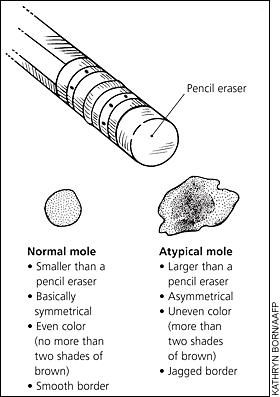
Am Fam Physician. 2008;78(6):741-742
See related article on atypical moles.
What are atypical moles?
Atypical moles are skin growths that are not cancerous.
What do they look like?
Atypical moles are usually bigger than 6 mm wide (about the size of a pencil eraser). They have an asymmetric shape and an uneven or jagged border. Atypical moles are usually more than two different shades of brown and are not the same color throughout (see drawing). They can sometimes look like a type of skin cancer called melanoma, but they are not melanoma.

Should I worry if I have an atypical mole?
Atypical moles can sometimes raise your risk of getting melanoma. The risk is higher in people who have a lot of atypical moles, especially if they also have family members who have had melanoma.
What if I have one?
Have your doctor examine your mole. He or she may remove the mole or have it checked for melanoma. Most atypical moles do not need to be removed.
What can I do to protect myself?
Watch your skin for new moles or any changes in your current moles. If you have a mole that bleeds or itches, tell your doctor right away. Also tell your doctor if your mole changes in size, shape, or color.
If you plan to be in the sun, wear a wide-brimmed hat, sunglasses, and protective clothing (for example, long sleeves and long pants). Use sunscreen that is SPF 15 or higher and reapply it every two hours. Try to stay out of the sun from 10 a.m. to 2 p.m. Never use a tanning bed.
See your doctor regularly for skin checks. Your doctor should examine your skin at least once a year.
Where can I get more information?
Your doctor
American Academy of Dermatology
National Cancer Institute